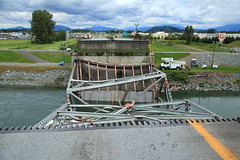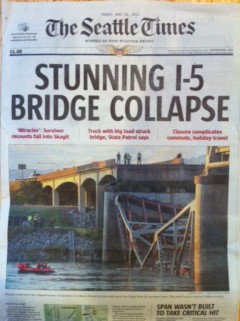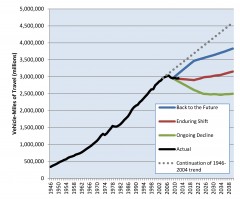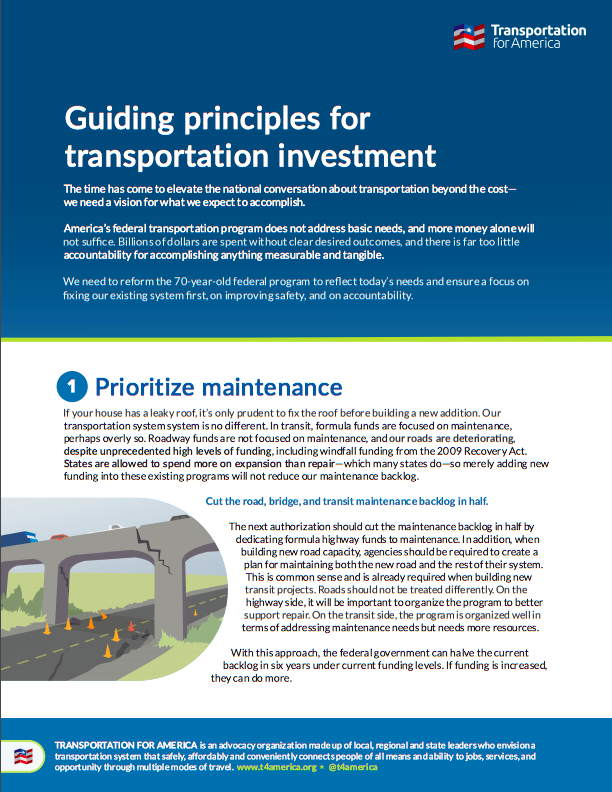Highlights from the great coverage of our bridge report
It’s easy to be cynical about our often frivolous media environment these days, but it is heartening to see the seriousness with which outlets of all sizes are treating reports about the need to maintain our aging bridges and other infrastructure. In addition to dozens of newspaper and web reports, more than 500 broadcast outlets have picked up yesterday’s release of the “The Fix We’re in For”, the 2013 edition of our report on bridge conditions nationwide.
The backlog of our country’s deficient bridges is indeed shrinking, but barely
We hope you had a chance to check out our new report yesterday on the state of our nation’s bridges? 1 in 9 US bridges — about 66,500 in total — are rated structurally deficient and in urgent need of repairs, maintenance or even replacement. This is an updated version of the data we released two years ago, and the findings are much the same: Everyday, Americans of all different stripes drive across these deficient bridges, with more than 260 million trips taken each day on these bridges. And though we’ve gotten about 0.5 percent better nationally in the last two years, from 11.5 to 11 percent total deficient, that’s only a difference of about 2,400 deficient bridges.
Release: New report highlights mounting challenge of aging bridges, ranks states
One in nine of the bridges and overpasses American drivers cross each day is rated in poor enough condition that some could become dangerous or be closed without near-term repair, according to an updated analysis of federal data released today by Transportation for America. Nearly 67,000 of the nation’s 605,000 bridges are rated “structurally deficient” and are in need of substantial repair or replacement, according to bridge inspections analyzed in The Fix We’re In For: The State of the Nation’s Bridges 2013. Nearly 8,000 are both structurally deficient and “fracture critical”, meaning they are designed with no redundancy in their key structural components, so that if one fails the bridge could collapse. The Federal Highway Administration estimates that the backlog of troubled bridges would cost $76 billion to eliminate.
One in 9 bridges still “structurally deficient” as average age nears 50 years
 One in nine of the bridges and overpasses American drivers cross each day is rated in poor enough condition that some could become dangerous or be closed without near-term repair, according to our new 2013 report on the nation’s bridges. Lay them all end-to-end and you could drive from Mexico to Canada across the US on one long deficient bridge. Don’t miss our new 2013 report and interactive map.
One in nine of the bridges and overpasses American drivers cross each day is rated in poor enough condition that some could become dangerous or be closed without near-term repair, according to our new 2013 report on the nation’s bridges. Lay them all end-to-end and you could drive from Mexico to Canada across the US on one long deficient bridge. Don’t miss our new 2013 report and interactive map.
Recognizing the Life and Service of Senator and Transportation Advocate Frank Lautenberg
On the news of Senator Frank Lautenberg’s (D-NJ) passing this morning, Transportation for America director James Corless released the following statement.
About those 66,000+ deficient bridges: What did last summer’s transportation law change?
 With the second collapse of an Interstate bridge in six years, Americans might expect Congress to leap into action to ensure adequate funding for bridge rehab and replacement. But as we have reminded numerous reporters since an I-5 bridge dropped into Washington’s Skagit River, federal lawmakers instead took a gamble and eliminated the nation’s dedicated bridge repair fund last summer.
With the second collapse of an Interstate bridge in six years, Americans might expect Congress to leap into action to ensure adequate funding for bridge rehab and replacement. But as we have reminded numerous reporters since an I-5 bridge dropped into Washington’s Skagit River, federal lawmakers instead took a gamble and eliminated the nation’s dedicated bridge repair fund last summer.
Bridge collapse in Washington captures national attention
Unsurprisingly, the sudden collapse of the 58-year-old Interstate 5 bridge over the Skagit River in Washington state last Thursday night captured the attention of the country and virtually all major national news outlets. Just like in the days after the Minnesapolis I-35W bridge collapse — though mercifully no one died in this incident — reporters scrambled to understand the issue of bridge condition and asked the same question: “how could this happen, and could it happen again somewhere else tomorrow?”
Tragic bridge collapse in Washington highlights urgent problem of aging and deficient US bridges
Transportation for America issued the following statement following last night’s collapse of the Interstate 5 bridge over the Skagit River near Mount Vernon, Washington.
“The shocking collapse of a busy Interstate 5 bridge over the Skagit River in Washington State highlights the issue of our country’s aging bridges and what we’re doing to address them. Thankfully, no one was killed or even seriously injured in this collapse, which could not be said about the last high profile bridge collapse in Minnesota.
58-year-old bridge collapses in Washington State on west coast’s most major interstate
 Shortly after the evening commute last night (around 7 p.m. local time) an entire section of the Interstate 5 bridge — both north and southbound lanes — over the Skagit River north of Seattle, Washington collapsed and fell into the river, sending two cars tumbling down into the river, injuring three yet miraculously killing no one. One of those who plunged into the river along with his wife called it a “miracle” that no one was killed or more severely injured.
Shortly after the evening commute last night (around 7 p.m. local time) an entire section of the Interstate 5 bridge — both north and southbound lanes — over the Skagit River north of Seattle, Washington collapsed and fell into the river, sending two cars tumbling down into the river, injuring three yet miraculously killing no one. One of those who plunged into the river along with his wife called it a “miracle” that no one was killed or more severely injured.
What happens when driving rates continue to drop?
 The typical American drives less today than at the end of Bill Clinton’s first term and the millennial generation (16-34) is leading the charge. But how likely is that trend to hold in the future? And if it does, what does that say about what we should be building, and how we will pay for it, if not with the gas taxes raised from driving? A game-changing new report seeks to answer the first question, and to fuel a conversation about the second.
The typical American drives less today than at the end of Bill Clinton’s first term and the millennial generation (16-34) is leading the charge. But how likely is that trend to hold in the future? And if it does, what does that say about what we should be building, and how we will pay for it, if not with the gas taxes raised from driving? A game-changing new report seeks to answer the first question, and to fuel a conversation about the second.





